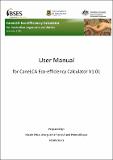| Author | Price, N |
| Author | Renouf, M |
| Author | Allsopp, P |
| Date Accessioned | 2015-04-13 |
| Date Available | 2015-04-13 |
| Issued | 2013 |
| Identifier | http://hdl.handle.net/11079/14235 |
| Abstract | CaneLCA calculates the eco-efficiency of sugarcane production over its lifecycle, to help sugarcane producers and their advisors identify sustainable farming practices. CaneLCA can assist sugarcane producers to: |
| Abstract | − understand on-farm and off-farm environmental impacts |
| Abstract | − identify where environmental impacts can be reduced |
| Abstract | − compare the eco-efficiency of different combinations of cane growing practices |
| Abstract | − verify the environmental benefits of new cane growing practices |
| Abstract | − inform decisions about changes to current farming practices. |
| Abstract | It was developed jointly by the University of Queensland and BSES Limited with funding from the Australian
Government and the Australian sugar industry through the Sugar Research and Development Corporation
(SRDC) (Project UQ045). |
| Abstract | CaneLCA is based on environmental life cycle assessment (LCA). It considers the environmental aspects
across the life cycle of sugarcane production from ‘cradle to farm gate’ (see Figure 1). This includes the
production of inputs to sugarcane growing (fertilisers, minerals, chemicals, capital goods, water, fuels and
electricity), the transport of inputs to the farm, and the environmental emissions that occur on the farm. |
| Abstract | It calculates environmental indicators for a range environmental aspects known to be important for
sugarcane growing – ENERGY USE, CARBON FOOTPRINT, WATER USE, and WATER QUALITY. |
| Abstract | CaneLCA is designed to make the LCA process as streamlined as possible for the user. The user enters data
describing the practices for a given sugarcane farm. The tool then uses in-built calculations, assumptions,
and environmental emission factors to calculate the relative eco-efficiency indicators per tonne of cane. |
| Abstract | The results are presented as an environmental profile graph with eco-efficiency ratings for each aspect (see
Figure 2). Users can interpret from the graph the sources of environmental impacts and opportunities for
improving eco-efficiency. The assessment can be repeated for different combinations of cane growing
practices so the user can compare the eco-efficiency of different practice options. |
| Language | en |
| Publisher | BSES |
| Part of Series | Internal report; 2013 UQ045 2010/045 |
| Subject | CaneLCA, eco-efficiency,environmental impacts, cane growing practices, LCA, energy use, carbon footprint, water use, water quality |
| Subject | Farming systems |
| Subject | Production management |
| Title | User manual for CaneLCA Eco-efficiency Calculator V1.01 |

